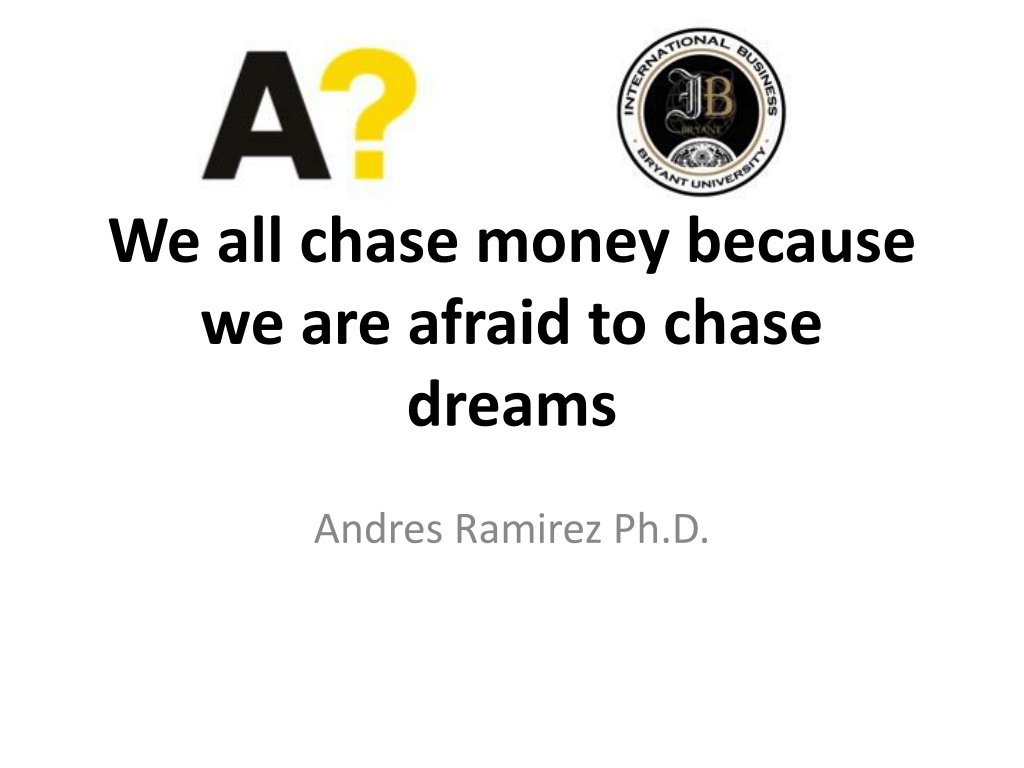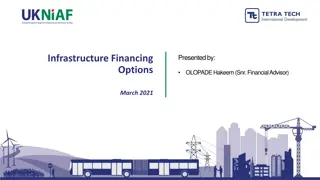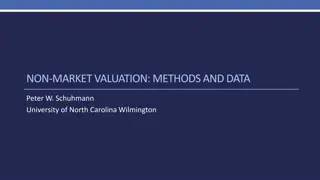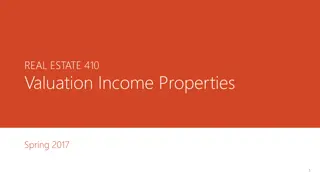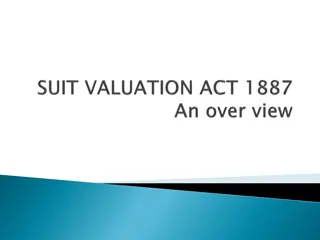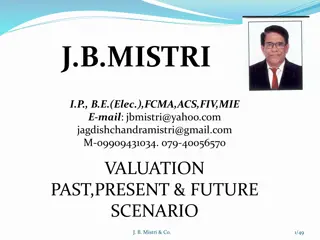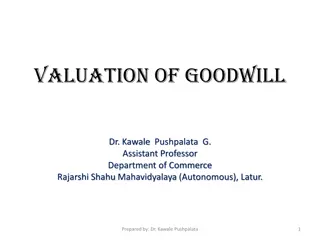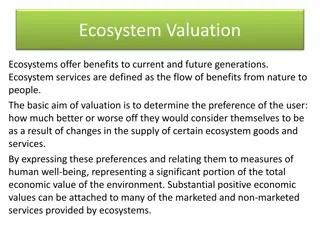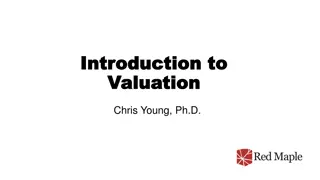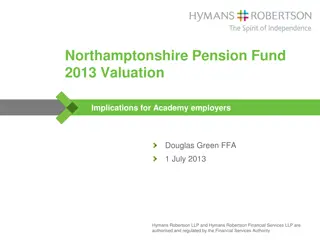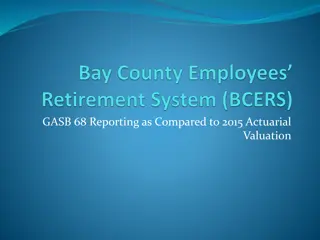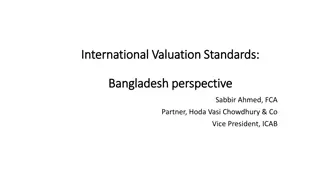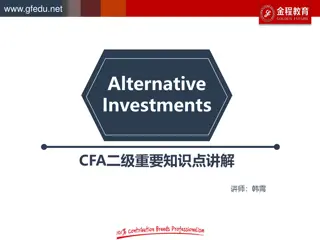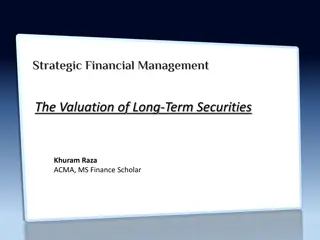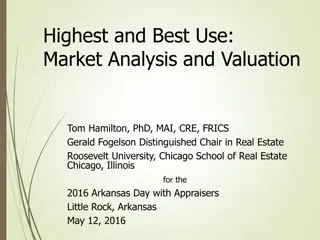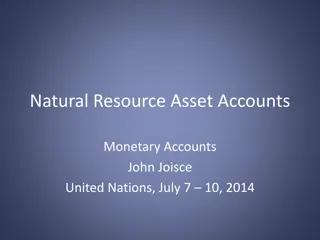Understanding Valuation Methods in Finance
Dive into the world of valuation methods in finance with insights on Discounted Dividend Model, Constant Growth Stock, implications of growth rates exceeding the required return, and practical examples like calculating required rate of return and stock prices using the Security Market Line. Explore the concepts of dividend streams, present values, and more to enhance your financial knowledge.
Download Presentation

Please find below an Image/Link to download the presentation.
The content on the website is provided AS IS for your information and personal use only. It may not be sold, licensed, or shared on other websites without obtaining consent from the author. Download presentation by click this link. If you encounter any issues during the download, it is possible that the publisher has removed the file from their server.
E N D
Presentation Transcript
We all chase money because we are afraid to chase dreams Andres Ramirez Ph.D.
Discounted Dividend Model Value of a stock is the present value of the future dividends expected to be generated by the stock. + + + (1 ) k (1 ) k (1 s s D D D D P = + + + k ... 1 2 3 0 + + 1 2 3 k ) (1 ) s s
Constant Growth Stock A stock whose dividends are expected to grow forever at a constant rate, g. D1 = D0(1 + g)1 D2 = D0(1 + g)2 Dt = D0(1 + g)t If g is constant, the discounted dividend formula converges to: + D (1 g) D P = = 0 1 0 k g k g s s
What happens if g > ks? If g > ks, the constant growth formula leads to a negative stock price, which does not make sense. The constant growth model can only be used if: ks > g. g is expected to be constant forever. Don t forget this on exam day!!
Example: Use the SML to Calculate the Required Rate of Return (ks) and then calculate Night Gallery s Stock Price Assume the following information: Night Gallery just paid a dividend of $2.00 which is expected to grow at a constant 6% per year. The risk free rate rRF = 7%, The return on the market rM = 12%, and Night Gallery s Beta = 1.2, What is the required rate of return on the firm s stock? What is Night Gallery s current stock price?
Example: Use the SML to Calculate the Required Rate of Return (ks) and then calculate Night Gallery s Stock Price rRF = 7%, rM = 12%, and b = 1.2, what is the required rate of return on the firm s stock? Note that (rM rRF)=RPM Market Risk Premium, be careful on what you are given ks = rRF + (rM rRF)b = 7% + (12% 7%)1.2 = 13%
Find the Expected Dividend Stream for the Next 3 Years and Their PVs D0 = $2 and g is a constant 6%. 0 1 2 3 g = 6% D0 = 2.00 2.12 2.247 2.382 1.8761 rs = 13% 1.7599 1.6509
What is the Night Gallerys intrinsic value? Using the constant growth model: D $2.12 P = = 1 0 g k 0.13 0.06 s $2.12 = 0.07 $30.29 =
What is the expected market price of the stock, one year from now? D1 will have been paid out already. So, P1 is the present value (as of Year 1) of D2, D3, D4, etc. D $2.247 P = = 2 1 k g 0.13 0.06 s $32.10 = Could also find expected P1 as: P P = $32.10 = (1.06) 1 0
Find Expected Dividend Yield, Capital Gains Yield, and Total Return During First Year Dividend yield = D1/P0 = $2.12/$30.29 = 7.0% Capital gains yield = (P1 P0)/P0 = ($32.10 $30.29)/$30.29 = 6.0% Total return (rs) = Dividend yield + Capital gains yield = 7.0% + 6.0% = 13.0%
What would the expected price today be, if g = 0? The dividend stream would be a perpetuity. 0 1 2 3 rs = 13% 2.00 2.00 2.00 PMT $2.00 P 0 = = $15.38 = r 0.13
Supernormal Growth: What if Night Gallery were going to rapidly grow g = 30% for 3 years before achieving long-run growth of 6%? Can no longer use just the constant growth model to find stock value. However, the growth does become constant after 3 years.
Valuing common stock with nonconstant growth D0 = $2.00 0 1 2 3 4 rs= 13% ... g = 30% g = 30% 3.380 4.394 g = 30% g = 6% 4.658 D0 = 2.00 2.600 2.301 2.647 3.045 4.658 P = = 3 = = $66.54 46.114 0.13 0.06 ^ 54.107 = P0
Valuing Common Stock with Nonconstant Growth 0 1 2 3 4 rs = 13% g = 30% g = 30% g = 30% g = 6% 4.658 D0 = 2.00 2.600 3.380 4.394 2.301 2.647 3.045 4.658 P = $66.54 = 46.114 3 0.13 . 0 06 P 0 54.107 =
Ramirez Company Ramirez Company is a great corporation going through an accelerated growth period. Its last dividend was 1.20. The CFO, Dr. Ramirez, expects that the dividend growth rate will be 30% for the next 5 years, after which dividends are expected to grow at a rate of 3% forever. You searched yahoo finance and found that the Beta for the company is 1.15. Additionally, you know that the risk free rate is 6%, and that the return on the market is 10%. What is the current stock price for Ramirez Company? Hint, you may want to start by using the CAPM, SML.
Corporate Valuation Model Also called the free cash flow method. Suggests the value of the entire firm equals the present value of the firm s free cash flows. Remember, free cash flow is the firm s after-tax operating income less the net capital investment. FC FCF F F F CF CF = + + + + ) FirmValue ... 1 2 3 0 + + + + 1 2 3 (1 r ) (1 r ) (1 r ) (1 r s s s s 9-18
A word about free cash flows What we should do Depr. and Capital = + + FCF EBIT(1 T) NOWC amortizati on expenditur es What we end up doing = Depreciati + FCF Net Income on - Capex
Applying the Free Cash Flow Model 1. Find the market value (MV) of the firm, by finding the PV of the firm s future FCFs. 2. Subtract MV of firm s debt and preferred stock (if any) to get MV of common stock. 3. Divide MV of common stock by the number of shares outstanding to get intrinsic stock price (value). 9-20
Issues Regarding the Corporate Valuation Model Often preferred to the discounted dividend model, especially when considering number of firms that don t pay dividends or when dividends are hard to forecast. Similar to discounted dividend model, assumes at some point free cash flow will grow at a constant rate. Horizon value (HVN) represents value of firm at the point that growth becomes constant. 9-21
Assume the following information 0 1 2 3 4 -5 10 20 A company has these cash flows, additionally you know that FCF will grow at a constant 6% rate after year 3. Assume also that k=10% and that the company has %40 million in debt. Finally, there are 10 million shares outstanding 9-22
Use the Corporate Valuation Model to Find the Firm s Intrinsic Value Given: Long-Run gFCF = 6% and WACC = 10% 0 1 2 3 4 k= 10% g = 6% -5 10 20 21.20 -4.545 8.264 15.026 398.197 416.942 21.20 = HV = 530 3 0.10 . 0 06 9-23
What is the firms intrinsic value per share? The firm has $40 million total in debt and preferred stock and has 10 million shares of stock. firm of MV equity of MV = = preferred and debt of MV 416 $ 94 . 40 $ = million 94 . 376 $ = Value per share quity/# e of MV = shares of 376 $ 94 . /10 = $37.69 9-24
Asset Betas Imagine company A and B, They are identical, except that company A has no debt and company B has 70% D/E. Could they sell for the same price? Different risks ???? ??????1 ? ???????= ?????? 1 +
